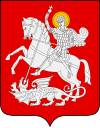Abbas I's Kakhetian and Kartlian campaigns
Abbas I's Kakhetian and Kartlian campaigns refers to the four campaigns Safavid king Abbas I led between 1614-1617,[6] in his East Georgian vassal kingdoms of Kartli and Kakheti during the Ottoman–Safavid War (1603–18). The campaigns were initiated as a response to the shown disobedience and subsequent staged rebellion by Abbas' formerly most loyal Georgian ghulams, namely Luarsab II of Kartli and Teimuraz I of Kahketi (Tahmuras Khan). After the complete devastation of Tbilisi, the quelling of the uprising and the deportation of between 130,000 - 200,000 Georgian captives to mainland Iran, Kakheti and Kartli were decisively brought under the Iranian sway.
Background
Tensions between Georgia and the Shah rose in 1612 as Teimuraz and Luarsab refused the Shah's summons and executed pro-Iranian nobility[1] including the governor of Karabakh. In the spring of 1614 war broke out. This event brought an end to the Treaty of Nasuh Pasha.
Massacres and deportations
In 1616, Shah Abbas I dispatched his troops to Georgia. He aimed to suppress the Georgian revolt in Tbilisi, however the Safavid soldiers met heavy resistance by the citizens of Tbilisi. The Shah ravaged Kakheti and Kartli as Teimuraz and Luarsab retreated to the Kingdom of Imereti. Luarsab surrendered to the Shah and was imprisoned, but Teimuraz's continued resistance enraged the Shah, who continued a campaign of massacres and deportations among the Georgians. Kartli was partially spared due to its allegiance to the Shah, while Kakheti lost the majority of its population.[1]
These deportations marked another stage in the Safavid policy of resettling huge amounts of Georgians and other ethnic Caucasian groups such as the Circassians and Armenians, to mainland Persia.
See also
References
Sources
- Blow, David (2009). Shah Abbas: The Ruthless King Who became an Iranian Legend. London, UK: I. B. Tauris & Co. Ltd. ISBN 978-1-84511-989-8. LCCN 2009464064.
- Matthee, Rudi (2011). Persia in Crisis: Safavid Decline and the Fall of Isfahan. I.B.Tauris. pp. 1–371. ISBN 0857731815.
- Mikaberidze, Alexander (2015). Historical Dictionary of Georgia (e ed.). Rowman & Littlefield. ISBN 978-1442241466.
- Parizi, Mohammad-Ebrahim Bastani (2000). "GANJ-ʿALĪ KHAN". Encyclopaedia Iranica, Vol. X, Fasc. 3. pp. 284–285.
- Ghafouri Ali History of the Iran's battles, from the Medes up to today 2009 ISBN 9789644237386.
- Asadollah Matoufi 4000 years history of Iran army, Persian title: Tārīkh-i chahār hazār sālah-i artish-i Īrān 2003 ISBN 9646820034.
- Roemer, H.R. (1986). "The Safavid period". The Cambridge History of Iran, Volume 5: The Timurid and Safavid periods. Cambridge: Cambridge University Press. pp. 189–351. ISBN 9780521200943.
